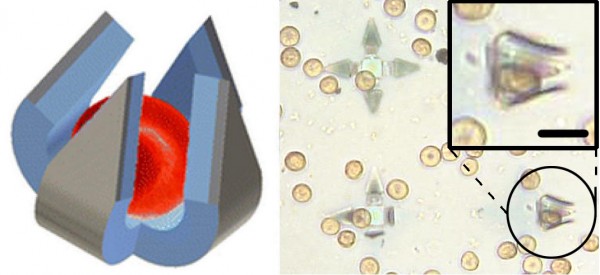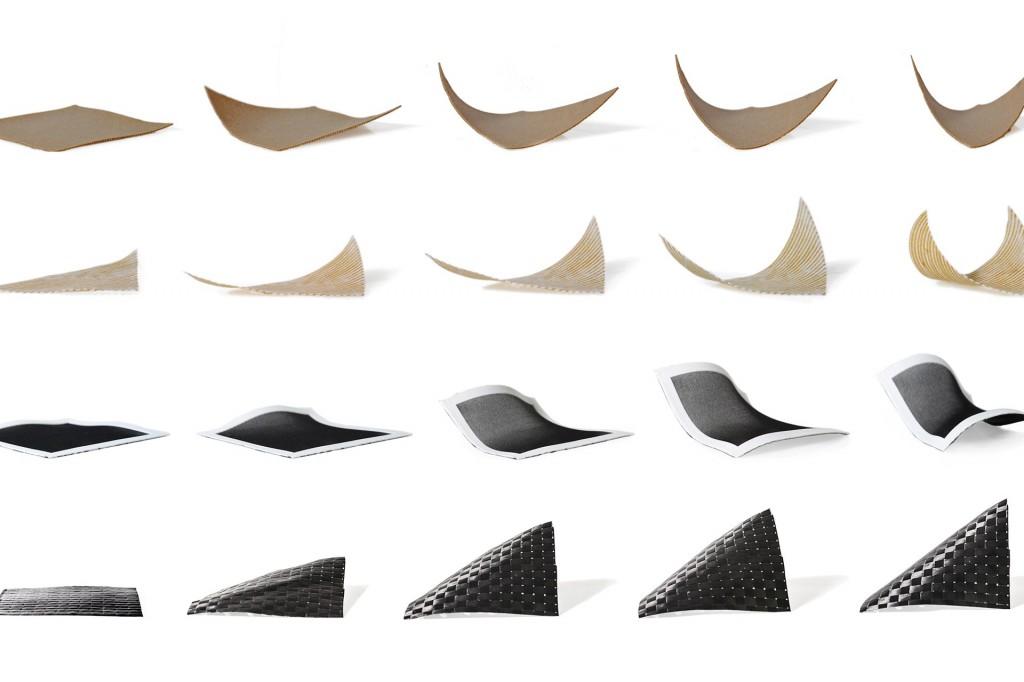3D 프린팅 지고 ‘4D 프린팅' 시대 온다 MIT Develops a Method for ‘4D Printing’ Programmed Carbon Fiber & Wood(VIDEO)

케이콘텐츠 kcontents
따뜻하면 공기가 잘 통하다가 추워지면 섬유 구조가 촘촘해지는 스마트 의류, 스스로 막힌 곳을 뚫는 수도관.
최근 과학계는 3차원(3D) 프린팅을 넘어 ‘4D 프린팅’ 연구가 한창이다. 4D 프린팅의 핵심은 부품 설계도를 3D 프린터에 넣고 출력하면 스스로 조립된다는 것. 물체가 스스로 조립된다는 점에서 3D 프린팅보다 한 단계 진화했다. 특히 최근 4D 프린팅 연구에서는 한국인 과학자들이 대거 활약하고 있다. 무생물에 생명을 불어넣다 지난해 여름 홍콩에서 열린 ‘미국전기전자공학회(IEEE) 로봇 및 자동화학회’에서는 ‘트랜스포머’처럼 스스로 조립되는 전등이 등장했다. 평면에 펼쳐진 몸체와 센서 등에 열을 가했더니 어느새 전등으로 변신한 것이다. 이 연구를 이끈 사람은 미국 하버드대 4학년에 재학 중인 한국인 학생 신병현 씨. 그는 2013년 로버트 우드 교수팀에 합류하면서 4D 프린팅 연구에 푹 빠졌고, 열을 가하면 스스로 접히는 상자와 학 등을 개발했다. 이 학회에서는 미국 매사추세츠공대(MIT) 다니엘라 루스 교수팀도 열을 가하면 스스로 조립되는 토끼를 내놨다. 이 연구를 주도한 사람도 한국인 과학자인 안병권 연구원이다. 그는 루스 교수 연구실에서 박사과정을 밟던 중 차세대 설계를 연구하는 오토데스크연구소의 선임연구원으로 자리를 옮겼다. 현재 안 연구원은 ‘4D 프린팅’이라는 용어를 처음 사용한 스카일러 티비츠 MIT 자기조립연구소장팀, 3D 프린터 업체 등과 공동으로 나무나 탄소섬유를 4D 프린팅에 적용하는 연구에 참여하고 있다. 코끼리나 축구공의 평면 설계도를 나무나 탄소섬유가 채워진 3D 프린터에 넣고 출력한 뒤 물에 담그면 입체 코끼리나 축구공으로 변신하는 식이다. 최근에는 길이 15m 막대를 3D 프린팅 한 뒤 물에 담가 입체 구조로 만드는 데도 성공했다. 안 연구원은 동아일보와의 e메일 인터뷰에서 “자체 개발한 프로그램에 원하는 모양을 입력하면 컴퓨터가 스스로 평면 설계도를 만들어 내는데, 이걸 출력해서 오븐에 넣기만 하면 물건이 나온다”면서 “무생물인 물질에 생명을 불어넣는 4D 프린팅 연구에 관심이 높아지면서 미국과학재단(NSF)도 3000만 달러(약 330억 원) 규모로 투자하고 있다”고 말했다. 자기조립 되는 소재를 프린터에 적용 꿈만 같은 4D 프린팅을 가능하게 만든 배경에는 자기조립 기술의 힘이 크다. 2007년 미 국방부 산하 고등방위연구계획국(DARPA)은 자기조립 연구에 지원하는 프로젝트를 가동했고, 2010년 우드 교수팀은 스스로 접히는 전자종이로 배나 비행기를 만드는 데 성공해 ‘미국국립과학원회보(PNAS)’에 발표했다. 이 연구에는 당시 박사후연구원이던 김상배 MIT 교수가 참여했다. 같은 해 로런스버클리 국립연구소 박사후연구원이었던 남기태 서울대 재료공학부 교수는 물속에서 저절로 조립되는 ‘분자종이’ 연구를 이끌기도 했다.  미국 연구진은 몸속에서 스스로 조립돼 암세포 하나를 집어낼 수 있는 장치를 개발했다. - 미국 존스홉킨스대 제공 현재 자기조립 기술은 더 정교해져 암 치료에까지 활용 폭을 넓히고 있다. 다비드 그라시아스 미국 존스홉킨스대 교수팀은 몸속에서 스스로 조립돼 암세포 하나를 집어낼 수 있는 장치를 개발했다고 지난해 ‘나노 레터스’에 발표했다. 문명운 한국과학기술연구원(KIST) 계산과학연구센터장은 “설계 기술과 함께 자기조립 되는 스마트 소재를 3D 프린터로 출력할 수 있도록 만드는 게 4D 프린팅 기술의 핵심”이라고 설명했다. “5년 내에 생활 바꿔놓을 것” 4D 프린팅은 국방 분야에서도 활용 가치가 높다. 미 육군은 2013년부터 위장천막이나 환경에 따라 색깔과 구조를 바꾸는 군용차량을 개발하기 위해 지원을 시작했고, 미 공군도 특정 상황에서 모양을 바꾸는 비행기 연구를 통해 스텔스 기능을 강화할 것으로 알려졌다. 4D 프린팅은 설계도와 프린터만 있으면 어디서든 원하는 물체를 만들 수 있다는 점에서 물체의 원격 전송을 가능하게 할 미래기술로 꼽히고 있다. 또 3D 프린팅은 출력할 수 있는 물체의 크기에는 한계가 있는 반면, 4D 프린팅은 출력 뒤에 조립되기 때문에 큰 물체도 얼마든지 만들 수 있다. 문 센터장은 “3년 내에 의류나 전자기기에 4D 프린팅이 적용되고, 5년 뒤면 의료나 로봇 분야에도 널리 활용될 수 있을 것”이라고 말했다. 동아사이언스 이재웅 기자 ilju2@donga.com |

by Debra Thimmesch What if you could train or, more precisely, program a material like wood, carbon or rubber to virtually complete the manufacturing process of whatever object it is destined to become? And what if the material continued transforming, adapting to its function or various functions? The Self-Assembly Lab at MIT has developed a method for programming materials such as hybrid plastics, wood grains, textiles, and carbon fiber to adjust their property and shape in response to anticipated conditions like an increase in temperature, pressure, or moisture. In a process that Skylar Tibbits, research scientists and director of the Self-Assembly Lab has called “4D printing,” materials like carbon fiber and rubber are programmed to behave, in a sense, like motorless, wireless, power source-less robots. When subjected to “passive energy sources,” explains Tibbits, the materials respond according to their respective functions. Skylar Tibbits When the Self-Assembly labs released its findings at TED in February of 2013, the response was surprising even to them despite understanding what a breakthrough they’d made. Applications they had not even considered were proposed and the enthusiasm was enormous. From construction, automotive, medical, and aviation industries to apparel and furniture, the researchers were encouraged to expand their own conceptions of what was now possible thanks to this new technology. After the unveiling of this technology, which Tibbits refers to as “4D printing”–the fourth dimension being time–the team at MIT began developing materials that would respond according to programmed parameters, to light, water, heat, air pressure, and so forth. Tibbits provided an example of a practical application for this technology. Carbon fiber that is programmed to be self-transforming is 3D printed accordingly. The carbon fiber, while fully cured, is produced with built-in flexibility. Depending on its function, different materials that activate it are 3D printed onto the carbon fiber. Airbus, which manufactures aircrafts, recognized the potential of this technological breakthrough in their industry. They needed to solve the problem of engine drag created by a robotic mechanism that regulates airflow to the engine. The programmed carbon fiber, because of its bi-directional nature, has the capacity to respond to heat in order to control airflow. Suddenly, the need for potentially failure-prone and often excessive parts and equipment like sensors, electronics and batteries is reduced. Also, carbon fiber and carbon-fiber composites, are both strong and extremely light. Another fascinating thread of research is Self-Assembly Lab’s work with rubber, which they are finding can be programmed and 3D printed–or 4D printed, allowing for the anticipated forces to which the materials will respond over time. Imagine: The rubber in your car’s tires could be programmed to respond to increased moisture or cold, changing their grip on ice or in rainy conditions. And then there is wood. Most everyone has experience with the issues involved when constructing something with wood. If it gets wet, for instance, an heirloom table can become a tragic reminder of its once elegantly-crafted self. The veneer curls away from its base, defying the glue that had adeptly held it in place. However, with programmed and 3D printed wood grains, adaptation to potentially damaging influences is built in and the material becomes resistant to undesirable distortion. 4D printed wood, plastic, canvas and carbon fiber The Self-Assembly Lab team has found a means of controlling materials to move, or otherwise respond by applying data from previous experiments to simulate influences or energy and change the wood grain’s response using the Autodesk software, Project Cyborg. Formerly, wood is steamed, molded, or pressure treated to get it to bend but with this technology, such labor-intensive efforts will potentially be a thing of the past. This also has exciting implications for shipping materials. A product made from programmed wood grains, for example, could be shipped flat and then programmed to transform into its ultimate shape–a bookshelf or a chair, for instance. Currently, technology is catching up with innovation as 3D printers are being developed to realize these new methods of creating not-quite-raw materials for use in an unimaginable myriad of ways. The response to this technology, which took Tibbits and his team somewhat by surprise, is probably less surprising to them now as they work to expand the possibilities and applications of Tibbit’s revolutionary “4D printing.” Let’s hear your thoughts on what this technology could be used for in the MIT 4D printing forum thread on 3DPB.com. Check out the two videos below provided by the Self-Assembly Lab at MIT showing off their self-assembling wood and carbon fiber: http://3dprint.com/19092/mit-self-assembly-4d-print/ |
"from past to future"
데일리건설뉴스 construction news
콘페이퍼 conpaper
.











